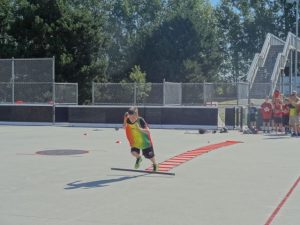
Fundamental Skills Analysis:
Cardio
- The anaerobic lactic and aerobic energy systems are the primary sources of energy in box lacrosse, both of which are trainable (with very specific responses). The key is to train and utilize each with a purpose, at particular times in a yearly training plan.
- The anaerobic lactic system is the energy system which is ultimately used the most while playing box lacrosse. It is defined as energy used in short bouts of high intensity, over a time period of 30 seconds to 2 minutes, with incomplete (intermittent) recovery periods. Lactic acid is the by-product of this process and must be removed (buffered) with help from the aerobic energy system, otherwise players' skill will drop off considerably throughout the course of a game/practice (due to interruptions in motor coordination).
- A general warm-up/dynamic stretches should be performed prior to all cardio-vascular training activities, with static stretches completed at the end where possible. In order to run a cardio drill to perfection, players should make sure to stop abruptly at the end of the cardio drill sequence. When instituting cardio-training into your practice plans, remember to do so at the end of practice, as the learning of new skills and strategies are best retained when players are relaxed, not tired (1:7 work:rest ratio).
In early off-season, training aerobically (continuous steady-state pacing) should be the predominant focus, creating a foundation of endurance and recovery capacity. It should then become a gradual transition to Anaerobic Lactic Training in the months and weeks leading up to, and throughout, the entire lacrosse season; while still maintaining aerobic capabilities with one aerobic training session per week (e.g. "recovery ride").
As an example, build up to doing aerobic cardio training 4 times per week (starting with 1-2), advance to doing anaerobic lactic training 1 time and aerobic training 3 times per week. Over a series of 2-4 week long cardio programs (mesocycles) work towards ratios of 2:2, then 3:1 anaerobic to aerobic, until finally arriving at the season and doing primarily interval-sprint cardio, with the odd aerobic recovery session. Sport-Specific Sprint Training should be progressively more specialized movements analyzed and applied in-season, ideally peaking in the post-season.
In general, cardio-vascular training should be done 2-4 times per week in order to see improvements, with the highest overall volume occurring late in the off-season ("specific-preparation" period). While "in-season," medium-high intensity practices are to be accounted for within the suggested 2-4 sprint-cardio workouts per week, depending at which point of the season the team is at. This may at times require the team to perform an extra cardio session outside of practice (ideally as a team). Remember to always take things slow in the beginning (don't increase total weekly volume more than 10%), with a recommended 2 times per week at the beginning of any new program, building up to 3-4 times in subsequent weeks.
After 3-4 weeks of making positive gains from a particular exercise drills will become stale and athletes will reach a "plateau," where further improvement becomes limited. The best way to overcome this barrier and to avoid over-training (aka burnout), is to regularly switch your cardio drills, we recommend doing so every 2-4 weeks (every mesocycle). The last week in the mesocycle is usually a transitional (unloading) week where the total volume should be dropped by 50% as a form of rest, while at the same time introducing newer more specific cardio techniques.
Interval training should never exceed 8% total volume. As a general rule, shorten recovery time before increasing intensity. If players drop more than 10% of initial interval (time - formally or informally), terminate the drill or increase the recovery time.
Initial studies we have undertaken to determine work to rest ratios are yet to be confirmed for elite Minor Lacrosse in Canada. However, we have researched and determined that professional box lacrosse players perform at a median work:rest ratio of 1:2, or 25 seconds work to 50 seconds rest, with every third shift being at a 1:3 ratio (TV time-outs, end of quarter, etc.,) and brief periods of on-floor rest/recovery (aka "critical moments").
Our hypothesis is that "minor" lacrosse would be closer to a 1:2 work:rest ratio as compared to the professionals. The shift length would also be expected to be longer because of the rules enforcing that players play "Both Ways," likely 45 seconds (work) to 90 seconds (rest). Thus, training at and around these intervals (also known as High Intensity Interval Training) while in-season will ultimately result in greater anaerobic capacity (keep this in mind when implementing cardio into your practice plans).
Cardio-vascular fitness should be measured during the pre-season & in-season at the very least (for elite players). We recommend using the sprint and agility drills found in our Lacrosse Specific Fitness Tests.
There are a lot of things to consider when considering cardio-training volume and implementation. It is best to consult with a strength and conditioning coach (C.S.C.S) to design a yearly training plan for your team, adjusting volumes and techniques appropriately.
It is also recommended that a carbohydrate-based electrolyte solution be used to aid in recovery during training/competition lasting longer than 60 minutes. This carb-electrolyte intake will help offset electrolyte (salt) loss, which would ultimately have a detrimental effect on energy output and muscle firing potential if not replaced.
- Categories: Beginner / Free / Drillbook / Cardio
